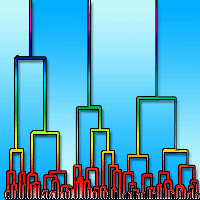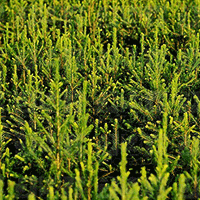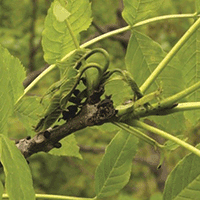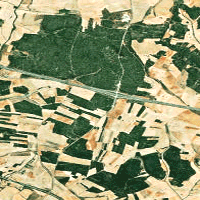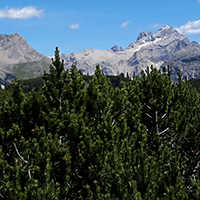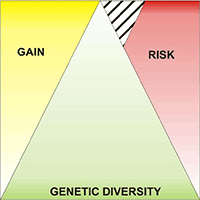
Comparison of genetic parameters between optimal and marginal populations of oriental sweet gum on adaptive traits
iForest - Biogeosciences and Forestry, Volume 11, Issue 4, Pages 510-516 (2018)
doi: https://doi.org/10.3832/ifor2450-011
Published: Jul 18, 2018 - Copyright © 2018 SISEF
Research Articles
Collection/Special Issue: COST Action FP1202
Strengthening conservation: a key issue for adaptation of marginal/peripheral populations of forest trees to climate change in Europe (MaP-FGR)
Guest Editors: Fulvio Ducci, Kevin Donnelly
Abstract
Genetic parameters of 9 oriental sweetgum (Liquidambar orientalis Mill.) populations were estimated at a common garden test. Open-pollinated seeds were collected from 16-27 families for each population. The common garden test was established in 2009 using a randomized complete block design in 25 blocks with single tree plot, with each block included 223 families. Breast height diameter, height and crown diameter were measured at the age of five. The purpose of study was to compare the genetic parameters of optimal and marginal populations and to assess the findings for genetic conservation. The study revealed significant variability in all traits evaluated. In variance components, variation among populations was three times higher than that of families. Individual heritability estimates for breast height diameter, height and crown diameter pooled across the whole dataset (marginal and optimal populations) were 0.21 ± 0.04, 0.27 ± 0.04 and 0.11 ± 0.03 and additive genetic coefficients of variation were 13.4%, 9.1% and 7.1%, respectively. Individual heritability estimates for breast height diameter, height and crown diameter in marginal and optimal populations were 0.27 ± 0.10, 0.19 ± 0.08 and 019 ± 0.08 and 0.19 ± 0.04, 0.29 ± 0.05 and 0.09 ± 0.03, respectively. Additive genetic coefficients of variation for breast height diameter, height and crown diameter were 16.7%, 8.3% and 10.8% in marginal and 12.8%, 9.1% and 6.2% in optimal populations, respectively. While breast height diameter and crown diameter were more heritable for marginal populations, height was more heritable for optimal populations. These findings are discussed in terms of genetic conservation of oriental sweet gum.
Keywords
Liquidambar orientalis, Genetic Variation, Individual Heritability, Gene Conservation, Climate Change
Authors’ Info
Authors’ address
Karabuk University, Faculty of Forestry, Karabuk (Turkey)
Corresponding author
Paper Info
Citation
Alan M (2018). Comparison of genetic parameters between optimal and marginal populations of oriental sweet gum on adaptive traits. iForest 11: 510-516. - doi: 10.3832/ifor2450-011
Academic Editor
Fulvio Ducci
Paper history
Received: Apr 04, 2017
Accepted: May 15, 2018
First online: Jul 18, 2018
Publication Date: Aug 31, 2018
Publication Time: 2.13 months
Copyright Information
© SISEF - The Italian Society of Silviculture and Forest Ecology 2018
Open Access
This article is distributed under the terms of the Creative Commons Attribution-Non Commercial 4.0 International (https://creativecommons.org/licenses/by-nc/4.0/), which permits unrestricted use, distribution, and reproduction in any medium, provided you give appropriate credit to the original author(s) and the source, provide a link to the Creative Commons license, and indicate if changes were made.
Web Metrics
Breakdown by View Type
Article Usage
Total Article Views: 47473
(from publication date up to now)
Breakdown by View Type
HTML Page Views: 39553
Abstract Page Views: 2962
PDF Downloads: 3909
Citation/Reference Downloads: 5
XML Downloads: 1044
Web Metrics
Days since publication: 2707
Overall contacts: 47473
Avg. contacts per week: 122.76
Citation Metrics
Article Citations
Article citations are based on data periodically collected from the Clarivate Web of Science web site
(last update: Mar 2025)
(No citations were found up to date. Please come back later)
Publication Metrics
by Dimensions ©
Articles citing this article
List of the papers citing this article based on CrossRef Cited-by.
References
Manual of quantitative genetics. Academic Enterprises, Pullman, WA, USA, pp. 191.
Gscholar
Genetic variability in two tree species, Acer platanoides L. and Betula pendula Roth, with contrasting life-history traits. Scandinavian Journal of Forest Research 18 (4): 320-331.
CrossRef | Gscholar
Introduction to quantitative genetics. Longman, Harlow, England, pp. 464.
Gscholar
Climate change 2013: the physical science basis. Contribution of Working Group I to the Fifth Assessment Report of the Intergovernmental Panel on Climate Change (Stocker TF, Qin D, Plattner GK, Tignor M, Allen SK, Boschung J, Nauels A, Xia Y, Bex V, Midgley PM eds). Cambridge University Press, Cambridge, UK, pp. 1535.
Gscholar
Determination of genetic structure of Anatolian sweetgum (Liquidambar orientalis Mill.) at the population and taxonomic levels based on molecular markers and development of in situ conservation strategies. The Scientific and Technical Research Council of Turkey, Agriculture, Forestry and Veterinary Research Grant Committee, Project Final Report Committee, TOVAG -104O156, pp. 45.
Gscholar
Approaches to the conservation of forest genetic resources in Europe in the context of climate change. European Forest Genetic Resources Programme - EUFORGEN, Bioversity International, Rome, Italy, pp. 46.
Online | Gscholar
Local adaptations to frost in marginal and central populations of the dominant forest tree Fagus sylvatica L. as affected by temperature and extreme drought in common garden experiments. Ecology and Evolution 4 (5): 594-605.
CrossRef | Gscholar
The phylogenetic analysis of Liquidambar orientalis Mill. varieties by comparing the non-coding trn regions of the chloroplast genome. Master thesis, Middle East Technical University, Ankara, Turkey, pp. 89.
Gscholar
Genetic differentiation of Liquidambar orientalis Mill. varieties with respect to matK region of chloroplast genome. Master thesis, Middle East Technical University, Ankara, Turkey, pp. 103.
Gscholar
Average genetic correlations among offspring from open-pollinated forest trees. Silvae Genetica 23 (5): 149-156.
Gscholar
Sigla ormanlarinin islahi, bakimi, sigla yagi istihsali ve kiymetlendirilmesi [Reclamation and tending in the forests of oriental sweet gum, oil production, and oil utilization]. Orman Genel Müdürlügü, Teknik Haberler Bülteni, Yil: 7, Sayi: 28: 3-23- [in Turkish]
Gscholar
Türkiye’deki sigla (Liquidambar orientalis Mill.) populasyonlarinin genetik yapisinin moleküler belirteçlerle belirlenmesi ve koruma stratejileri gelistirilmesi [Determination of genetic diversity and gene conservation strategies for oriental sweetgum (Liquidambar orientalis Mill.) populations in Turkey by molecular markers]. Orman Agaçlari ve Tohumlari Islah Arastirma Müdürlügü Teknik Bülten No: 20. 43 s., Ankara. [in Turkish with English summary]
Gscholar

